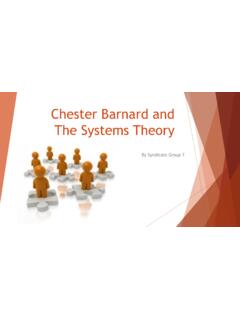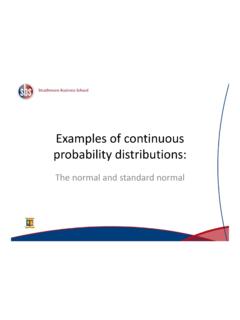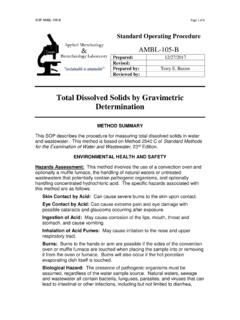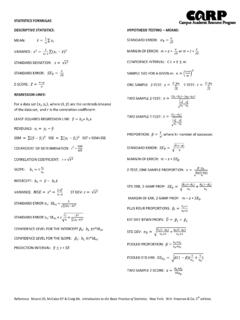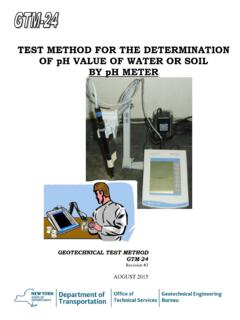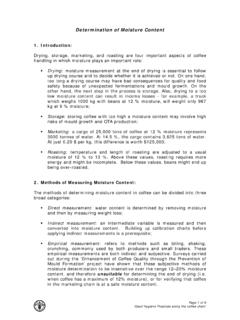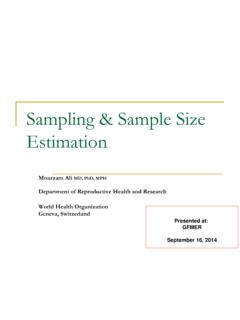Transcription of Sampling and Sample Size Determination - Strathmore …
1 Sampling and Sample size Determination Terms Sample Population Population element Census Why use a Sample ? Cost Speed Accuracy Destruction of test units Steps Definition of target population Selection of a Sampling frame (list) Probability or Nonprobability Sampling Sampling Unit Error Random Sampling error (chance fluctuations) Nonsampling error (design errors) Target Population (step 1) Who has the information/data you need? How do you define your target population? - Geography - Demographics - Use - Awareness Operational Definition A definition that gives meaning to a concept by specifying the activities necessary to measure it.
2 -Eg. Student, employee, user, area, major news paper. What variables need further definition? (Items per construct) Sampling Frame (step 2) List of elements Sampling Frame error Error that occurs when certain Sample elements are not listed or available and are not represented in the Sampling frame Probability or Nonprobability (step 3) Probability Sample : A Sampling technique in which every member of the population will have a known, nonzero probability of being selected Non-Probability Sample : Units of the Sample are chosen on the basis of personal judgment or convenience There are NO statistical techniques for measuring random Sampling error in a non-probability Sample .
3 Therefore, generalizability is never statistically appropriate. Classification of Sampling Methods Sampling Methods Probability samples Simple Random Cluster Systematic Stratified Non- probability Quota Judgment Convenience Snowball Probability Sampling Methods Simple Random Sampling the purest form of probability Sampling . Assures each element in the population has an equal chance of being included in the Sample Random number generators Probability of Selection = Sample size Population size Advantages minimal knowledge of population needed External validity high; internal validity high; statistical estimation of error Easy to analyze data Disadvantages High cost.
4 Low frequency of use Requires Sampling frame Does not use researchers expertise Larger risk of random error than stratified Systematic Sampling An initial starting point is selected by a random process, and then every nth number on the list is selected n= Sampling interval The number of population elements between the units selected for the Sample Error: periodicity- the original list has a systematic pattern ?? Is the list of elements randomized?? Advantages Moderate cost; moderate usage External validity high; internal validity high; statistical estimation of error Simple to draw Sample ; easy to verify Disadvantages Periodic ordering Requires Sampling frame Stratified Sampling Sub- samples are randomly drawn from samples within different strata that are more or less equal on some characteristic Why?
5 Can reduce random error More accurately reflect the population by more proportional representation Advantages minimal knowledge of population needed External validity high; internal validity high; statistical estimation of error Easy to analyze data Disadvantages High cost; low frequency of use Requires Sampling frame Does not use researchers expertise Larger risk of random error than stratified Systematic Sampling An initial starting point is selected by a random process, and then every nth number on the list is selected n= Sampling interval The number of population elements between the units selected for the Sample Error: periodicity- the original list has a systematic pattern ?
6 ? Is the list of elements randomized?? Advantages Moderate cost; moderate usage External validity high; internal validity high; statistical estimation of error Simple to draw Sample ; easy to verify Disadvantages Periodic ordering Requires Sampling frame Stratified Sampling Sub- samples are randomly drawn from samples within different strata that are more or less equal on some characteristic Why? Can reduce random error More accurately reflect the population by more proportional representation How? variable(s) as an efficient basis for stratification.
7 Must be known to be related to dependent variable. Usually a categorical variable list of population elements must be obtained randomization to take a simple random Sample from each stratum Types of Stratified samples Proportional Stratified Sample : The number of Sampling units drawn from each stratum is in proportion to the relative population size of that stratum Disproportional Stratified Sample : The number of Sampling units drawn from each stratum is allocated according to analytical considerations as variability increases Sample size of stratum should increase Types of Stratified Optimal allocation stratified Sample : The number of Sampling units drawn from each stratum is determined on the basis of both size and variation.
8 Calculated statistically Advantages Assures representation of all groups in Sample population needed Characteristics of each stratum can be estimated and comparisons made Reduces variability from systematic Disadvantages Requires accurate information on proportions of each stratum Stratified lists costly to prepare Cluster Sampling The primary Sampling unit is not the individual element, but a large cluster of elements. Either the cluster is randomly selected or the elements within are randomly selected Why? Frequently used when no list of population available or because of cost Ask: is the cluster as heterogeneous as the population?
9 Can we assume it is representative? Cluster Sampling example You are asked to create a Sample of all Management students who are working in Lethbridge during the summer term There is no such list available Using stratified Sampling , compile a list of businesses in Lethbridge to identify clusters Individual workers within these clusters are selected to take part in study Types of Cluster samples Area Sample : Primary Sampling unit is a geographical area Multistage area Sample : Involves a combination of two or more types of probability Sampling techniques.
10 Typically, progressively smaller geographical areas are randomly selected in a series of steps Advantages Low cost/high frequency of use Requires list of all clusters, but only of individuals within chosen clusters Can estimate characteristics of both cluster and population For multistage, has strengths of used methods Disadvantages Larger error for comparable size than other probability methods Multistage very expensive and validity depends on other methods used Classification of Sampling Methods Sampling Methods Probability samples Simple Random Cluster Systematic Stratified Non- probability Quota Judgment Convenience Snowball Non-Probability Sampling Methods Convenience Sample The Sampling procedure used to obtain those units or people most conveniently available Why: speed and cost External validity?

